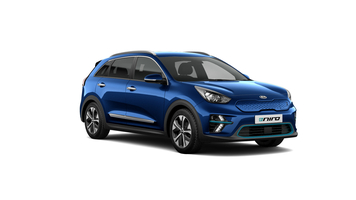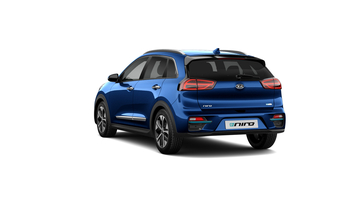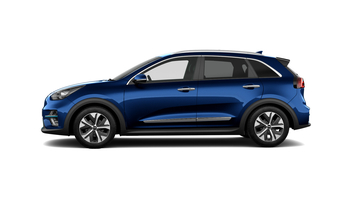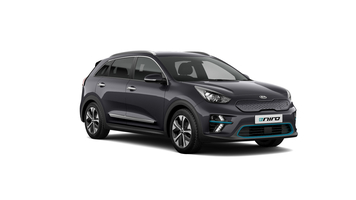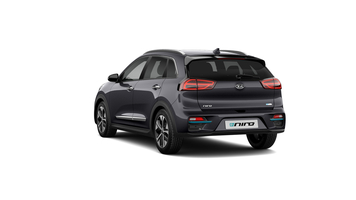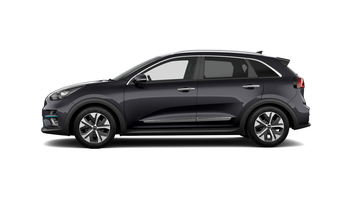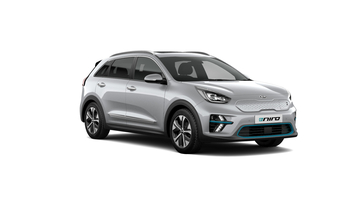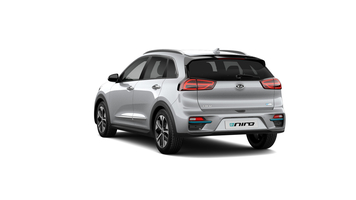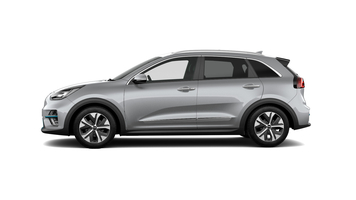- Expanded three-model line-up
- More affordable 39kWh electric motor option available in the UK for the first time
- Three-phase 11kW AC charger makes its debut, fitted as standard on the new flagship ‘4+’ grade
- Prices start at £29,595 (after Plug-in Car Grant)
- New model range on sale now
As if there wasn’t already a long list of reasons why buyers should choose the full-electric e-Niro to adorn their driveway, Kia has today added some additional benefits. Up until now, the e-Niro has been available in a single, high specification model, but that now changes with an expansion of the line-up to include three feature rich versions named ‘2’, ‘3’ and ‘4+’.
For the first time the 39kWh battery pack will be available to UK buyers. The battery is capable of travelling up to 180 miles on a single charge, and produces the same zero tailpipe CO2 emissions, while on the WLTP city cycle, it can travel up to 251 miles. The battery pack is paired with a 134bhp (100kW) electric motor that produces 395Nm of torque and allows the e-Niro to accelerate to 60mph in a sprightly 9.5 seconds. Available on the ‘2’ specification, the newcomer is priced at just £29,595, after the Plug-in Car Grant has been deducted (£32,595 without).
It joins a pair of high specification models in ‘3’ and ‘4+’ grades that feature the high-powered 64kWh battery pack. A driving range of more than 282 miles on a single charge is possible, and up to 382 miles when measured on the WLTP city cycle. The long-distance 64kWh battery pack is combined with a 201bhp (150kW) electric motor that packs 395Nm of torque and enables acceleration from 0-to-60mph in just 7.5 seconds.
e-Niro delivers more choice in three highly specified versions
New for summer 2020 is a well-specified three-model e-Niro line-up, encompassing grade ‘2’, level ‘3’ and a top-of-the-range ‘4+’ edition, with the ‘+’ moniker symbolising that it incorporates an AC 11kW three-phase charger as standard, the first time that it has been offered on the e-Niro.
The e-Niro ‘2’ builds on the high specification of the Niro Hybrid and PHEV ‘2’ models by adding 17-inch alloy wheels, a 7-inch full TFT Colour Display Cluster, chrome beltline mouldings, a powered driver’s seat lumbar support, a charging indicator on the dashboard, battery heating system and an engine start/stop button with Smart Entry System.
This is in addition to black cloth and leather upholstery, high gloss black trim for the steering wheel, lower console, door inserts, and centre fascia and a leather trimmed steering wheel and door armrests. The rear seats fold down in a 60:40 arrangement, and there’s a luggage area load cover and luggage net hooks provided as standard. Up front, there’s a matt black radiator grille, black side sill and wheel arch body mouldings to match and chrome coated exterior door handles.
Automatic air conditioning is included within the specification, in addition to all-round electric windows with driver and front passenger automatic up and down functionality, an electric parking brake (EPB) with autohold, Adaptive Smart Cruise Control (SCC) with Stop and Go, a speed limiter and an auto-dimming rear-view mirror. Automatic headlight control, rain sensing front wipers, electrically folding, adjustable and heated door mirrors with LED indicators are also included, along with privacy glass, a rear spoiler and roof rails. Shining the way ahead are projection headlights with LED daytime running lights, front fog lights and rear combination lamps that incorporate LED technology.
An 8.0-inch touchscreen display dominates the centre console, which includes Android AutoTM and Apple CarPlayTM smartphone compatibility, as well as Bluetooth® with music streaming. The DAB radio includes MP3 compatibility, steering wheel controls and six-speakers, along with a pair of USB ports, one of which is a fast charger. A reversing camera system is integrated into the touchscreen and is combined with the convenience of rear parking sensors.
A Forward Collision-Avoidance Assist (FCA) system is standard equipment, designed to prevent accidents due to inattention from the driver. If the system senses that the driver hasn’t reacted to an event ahead, the car can automatically bring the car to a stop or lessen the impact of a crash. Lane Keep Assist System (LKAS) uses a windscreen-mounted camera to monitor the vehicle’s position in the lane, with the system able to guide the e-Niro back into the centre of the lane. Hill-start Assist Control (HAC) maintains brake pressure on a hill as you switch from the brakes to the accelerator pedal, helping to avoid the car rolling back unintentionally. Driver Attention Warning (DAW) guards against tiredness on the move and alerts the driver should the car’s electronics detect any sign of drowsiness, prompting the driver to take a break.
Other life-saving safety equipment included on all e-Niro models includes Anti-lock Braking System (ABS), Electronic Stability Control (ESC), Emergency Stop Signalling (ESS) and Tyre Pressure Monitoring System (TPMS). Smart Cruise Control (SSC) with stop and go works in association with all of the other safety systems on the car to keep a safe distance from the car in front, slowing down and speeding up automatically according to the flow of the traffic. If another vehicle cuts in front, the system will automatically brake and adjust the speed of the e-Niro until a safe distance is once again achieved. Seven airbags are included as standard, including a knee airbag for the driver, while the front passenger airbag can be disabled via a cut-off switch. ISOFIX Child Seat Top Tethers and Anchor Fixings are included, too, so that child car seats can be fitted.
Move up to ‘3’ specification and there’s the addition of black full leather upholstery, an 8-way power adjustable driver’s seat, heated front seats and steering wheel, wireless mobile phone charger for Qi-equipped smartphones and aluminium door scuff plates.
In-car entertainment has never been more important, and that’s why the e-Niro ‘3’ is fitted with latest 10.25-inch touchscreen satellite navigation system with European mapping and Traffic Messaging Channel (TMC). In addition, Kia Connected Services includes TomTom® Live that incorporates traffic, speed cameras, local search and weather updates. UVO CONNECT puts a raft of information at owners’ fingertips, including live traffic, weather, and parking availability. UVO CONNECT also provides vehicle charging information, including charging station locations, charger availability, and connection compatibility. The system can also be accessed via a UVO smartphone app, providing remote access to a range of vehicle functions.
At the pinnacle of the 2021 model year range, the e-Niro ‘4+’ boasts a one-touch tilting and sliding power sunroof, LED headlights with bi-function projection, memory functionality for the driver’s seat and door mirrors, heated outer rear seats and ventilated front seats. There’s ambient lighting, aluminium pedals, an 8-speaker, 320-watt JBL® premium sound system with subwoofer, external amplifier and front centre speaker and front parking sensors. Intelligent Speed Limit Warning (ISLW) also features, in addition to the AC 11kW three-phase charger.
Fast charging takes just 54 minutes
Charging the lithium-ion polymer battery up to 80 per cent only takes 54 minutes using a 100kW direct current (DC) fast charger, no matter whether the 39kWh or 64kWh e-Niro is chosen. Using a 50kW DC charger, the 39kWh versions charges to 80 per cent in 57 minutes, while the 64kWh version takes 75 minutes. Drivers also have the option of charging their car at a compatible regular household power socket using the ICCB-cable (in-cable control box). The charging port is located at the front of the car, underneath a flap that is integrated into the aerodynamically optimised ‘tiger nose’ grille. Two battery charging cables are supplied with the e-Niro; one with a standard three-pin plug, allowing the car to be connected to a domestic socket and a Type 2 to Type 2 cable for connection to a public or workplace charging point.

